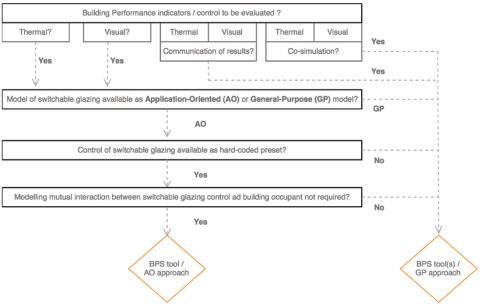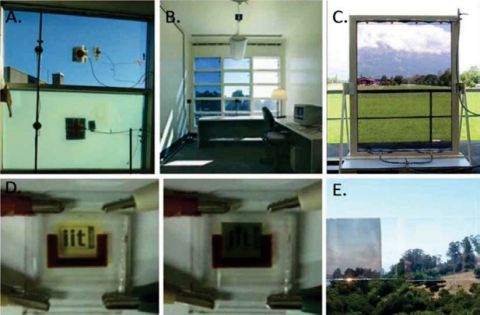The integration of smart glazing and adaptive façade in buildings can lead to large performance improvements and added functionality compared to conventional static building envelope systems.
This is achieved not only by embedding automatic/controllable (smart/active) switchable materials into the building envelope, but also including intelligence into the way the whole building is designed and operated.
Desk studies and Building Performance Simulation can be used to support the design process of these technologies and of the building integrating them, as well as to support product development aimed at building integration of novel switchable glazing technologies.
Although BPS tools traditionally lag behind the development of novel technologies and adaptive building envelope systems, therefore it is not always possible or easy to evaluate in an accurate and comprehensive way the performance of building integrated switchable glazing technologies, and in general adaptive facades.
In this paper we outline the main requirements for BPS of smart glazing. These include user interface requirements, models availability, integration of physical domains, integration and customisation of control strategies.
We analyse possible BPS tools that could be used and their main advantages and drawbacks, and describe the latest advances for more integrated simulation methodologies and tools, included an adhoc developed simulation tools which aims at overcoming the main limitation of traditional BPS tools.
The potential of smart (switchable or adaptive) glazing technologies to improve building performance is due to their ability to modulate their thermo-optical properties in response to external stimuli, enabling the modulation of the amount of solar radiation entering the indoor environment in response to transient boundary conditions (external, such as climate, or internal, such as occupants’ requirements).
a) indoor environmental conditions in terms of visual (e.g. daylight utilization, glare discomfort, view to outside) and thermal (e.g. overheating in summer) comfort aspects, as well as privacy;
b) building energy use and carbon emissions (by reducing heating, cooling and lighting energy use at the same time, by controlling these switchable glazing in an intelligent way).
Different materials and systems are used as functional layers to modulate thermo-optical properties in switchable glazing, including, chromogenic materials (e.g. thin-film metal compounds), liquid crystals and suspended particles. The main differences between various types of switchable windows can be summarized with the following features:
Smart glazing compete with dynamic solar shading technologies on different aspects, from improved building performance, to building and component integration issues, control strategies, maintenance strategies, initial and operating costs etc..
Both smart glazing and dynamic solar shading technologies present different advantages and disadvantages, which may be generally valid or project specific. This comparison is not in the scope of this paper, although most of the considerations presented in this work regarding the evaluation of their performance can be applied to both.
Different types of switchable windows are commercially available on the market (Fig. 1 and 2). Baetens et al. (2010), Jelle et al. (2012) and Favoino et al. (2015) provide extensive overviews of the stateof- the-art in this field.
Input data for switchable windows is available at glazing manufacturers such as View Inc, SAGE (electrochromics), Raven Windows (thermotropics), Merck (liquid crystals), and via the International Glazing Database (IGDB) that is linked to the LBNL Window software. In figure 1 the performance of established (continuous lines) and innovative (dashed lines) smart glazing technologies is compared to conventional static glazing (data points) in terms of thermo- optical properties (g-value on the x-axis and visible transmission on the y-axis), the main difference and advantage is that smart glazing (continuous and dashed lines) are able to modulate their properties between different states compared to conventional glazing, represented only by one set of properties (data point).
Besides the capability of the switchable glazing to actively manage the solar radiation entering the built environment, it is the way it is controlled that finally determine which performance objective is improved and to which extent, as an adaptive behaviour itself does not automatically guarantee effective operations (Wickmans et al. 2005). In this context, Building Performance Simulation (BPS) a quantitative and true comparison between different materials (either adaptive or static), products and controls, by means of overall building performance metrics, i.e. total primary energy, comfort/discomfort indexes, overall indoor environmental quality and whole life value indicators etc.. However, simulation of smart glazing can be significantly more complex than performance prediction of conventional static facades, as existing simulation tools were not originally developed for this purpose.
The present paper aims at guiding professionals and researchers in understanding the issues related to BPS of smart glazing, and selecting the best suited models, tools and simulation strategies to suit their purposes.
2. Building Performance Simulation requirements for smart glazing
Most BPS tools stem from a time when variation of thermo-optical properties of building components and their control was not a primary consideration (Oh and Haberl 2015), restricting the options for modelling switchable glazing and adaptive facades. The requirements and limitations of BPS tools to evaluate the performance of buildings integrating switchable glazing can be grouped into the following areas (Loonen et al. 2016):
a) Multi-domain integration of performance evaluation Switchable glazings influence both visual and thermal performance aspects of a building. The interactions between these physical domains need to be taken into account in an appropriate way, depending on the purpose of the evaluation (i.e. the building performance indicators under evaluation) and on the control mechanisms of the switchable glazing. Whenever a thermal/energy performance indicator need to be evaluated (i.e. building loads, building energy use, temperatures, thermal comfort etc…) together with a visual comfort indicator (i.e. glare index, light levels etc.) and/or the adaptation of the façade is triggered by a result in another physical domain, virtual physical models representing only one physical domains (i.e. only thermal or visual) or two independent physical domains (i.e. one thermal and one visual model independent from each other) cannot provide reliable results (Favoino et al. 2017) (cf. Section 4).
b) User interface definition of switchable glazing: Two types of modelling approaches can be distinguished: (i) application-oriented and (ii) generalpurpose approach. Application-oriented (AO) indicates that the user can select a specific material / glazing model between the one already available in the BPS tool. Therefore the switching mechanisms and how it is triggered are already embedded in the specific model, and users can activate it easily by means of the graphical user interface, but they are limited to the pre-sets available. The general-purpose (GP) features, on the other hand, are not restricted to a specific technology, but offer the user flexibility to define the way thermo-physical properties varies within the switchable glazing and/or their control mechanisms (either passive or active).
c) Solution routines for transient heat conduction through building elements: it is important that the switching of window properties happens during simulation run-time, because the changing amount of solar radiation that enters the zones leads to a different transient thermal response of the space. Although the methods to solve heat transfer phenomena differential equations in BPS tools can only work with time-invariant thermo-physical properties (i.e. density, specific heat capacity, thermal conductivity), the models for calculating energy gains/losses through transparent portions of the building envelope, on the other hand, do not normally include thermal storage effects (Freire et al. 2011)several intensive studies have been carried out in order to reduce the energy consumption of buildings. One solution lies on whole building energy simulation that permits to enable the heat (and moisture. For this reason it is easier to take dynamically changing window properties into account.
d) Control strategies: for AO options, the user can only select between the control strategies pre-coded in the BPS tools (hard-coded control), whether these are intrinsic (depending on a state of the material, i.e. glazing temperature) or extrinsic switchable glazing (depending on an external stimulus, i.e. room air temperature). Time-scheduled control is generally available, but the user can only pre-define control actions as a function of time. Some BPS tools presents scriptbased control capabilities, allowing the user to code the preferred control strategy in the simulation tool, replicating and extending the hard-coded pre-set options to suit the specific control requirements of the switchable glazing. Hard-coded presets or script-based controls are extremely suitable for evaluating the performance of rule based controlled switchable glazing, this is by far the most adopted control option in the market (Oldewurtel et al. 2012), and many studies adopts this to test the performance of switchable glazing technologies (Jonsson and Ross, 2010; Fernandes and al. 2013). More advanced control strategies for switchable glazing, such as advanced rule based or Model Predictive Control strategies, can only be evaluated by adopting script based control in combination with more advanced simulation strategies (Favoino et al. 2016, De Forest et al. 2017, cf. Section 4).
e) Occupant interaction: scarce information and modelling capabilities is available to model the way individual occupants may want to control a specific switchable glazing technology. This capability requires behavioural models that describe the interaction of building occupants with adaptive building envelope systems. Until now, such occupant interactions can only be implemented via script-based control approaches (Yan et al. 2015, Gunay et al. 2015).
Based on these requirements building designers and researchers need to assess the most appropriate tool and methodology to simulate switchable glazing to suit their purpose. In Figure 3 a flow chart diagram is used to guide this evaluation, to understand whether the switchable glazing under investigation can or cannot be simulated with current BPS tools, and which modelling approach should be used.

Figure 3. Proposed workflow to select BPS tools according to simulation requirements and characteristics of switchable glazing technology
3. Implementation of smart glazing models and controls into BPS tools
As a result of their presence in the market, options for AO modelling of switchable glazing technologies are embedded in many of the widely-used simulation tools (EnergyPlus, ESPr, IDA ICA, IES VE and TRNSYS) Such implementations offer the possibility to control the properties of the building model’s fenestration systems during simulation runtime.
3.1. Application oriented modelling capabilities
Most of extrinsically controlled switchable glazing, such as electrochromic, SPD and liquid crystal devices could be modelled in BPS tools with the AO approach, by defining different glazing states (each one with specific thermo-optical properties) and linking these with a pre-set hard coded control. The differences between the various implementations are the number of possible window states (e.g. on/off versus gradual transitions) and the simulation state variables that can be used for the control of adaptation (e.g. room temperature, ambient temperature and incident radiation).
Intrinsically controlled switchable glazing, such as thermotropic/chromic windows, are slightly more complicated to simulate than other switchable window types because of:
a) intrinsic control: adaptation of the fenestration properties is directly triggered by window material temperature instead of a control signal that is based on more general simulation variables;
b) hysteretic behavior: most thermochromic / thermotropic functional layers presents a different variation of thermal properties according to material temperature when undergoing heating or cooling (Warwick et al, 2013). This hysteresis can have a significant impact on the heating and cooling energy use of buildings (Warwick and Binions, 2014), although until no study exists on the influence of this behavior also on thermal and visual comfort.
A provision for thermochromic window simulation is implemented in EnergyPlus since v3.1 and ESP-r. The input of these models consists of sets of glazing thermooptical properties at various temperatures.
During the simulation, the thermochromic layer temperature of the previous time step is automatically fed into a window control algorithm, which then selects the window properties that best match with the given temperature. In IDA ICE and Trnsys, it is also possible to model thermotropic/chromic windows, but a significantly higher level of work and expertise is required from the user side because a script for the control strategy needs to be manually developed by the simulation user. The hysteretic behavior of switchable window cannot be modelled in any BPS tools (Saeli et al., 2010), although some researchers developed a simplified approach to evaluate its effect (Warwick et al, 2013) by a two-step simulation process, aimed at developing a correlation between thermochromic window states (optical properties) and climate boundary conditions (i.e. solar irradiance on the glazing).
Figure 4 shows how 5 of the most adopted BPS tools implement AO modelling capabilities and control modelling capabilities. These tools (EnergyPlus, ESPr, IDA ICE, IES VE and TRNSYS) are selected as they present i) the largest user community among designer and researchers, ii) extensive building envelope modelling capabilities and iii) they are widely validated. On the right of Figure 4 different switchable glazing technologies are represented and connected with the BPS tool which presents any AO modelling capabilities regarding that specific technology. While on the left hand side of Figure 4, the control options available in each simulation tool are outlined.

Figure 4. Implementation of Application Oriented modelling and control capabilities in existing BPS tools
Not all hard coded control options are available for all switchable glazing technologies, especially for intrinsic technologies (i.e. thermochromic glazing). This graphical representation will be hosted in a web based tool, allowing the user to define the switchable glazing technology and its control strategies and to identify to most suited simulation tool to fit his/her purpose, and vice-versa to select his/her preferred simulation tool and understand its modelling capabilities.
3.2. General purpose modelling capabilities
In order to overcome the limitations set by AO modelling approaches, researchers and designers oriented towards the tools allowing more GP modelling approaches. EnergyPlus, ESPr and TRNSYS allow the user to adopt the general oriented approach to simulate a smart glazing:
a) ESP-r: this is a simulation tool with an open-source environment aimed at the research community. Since its first version, various groups have contributed general-purpose functionalities for modeling adaptive facade technologies. The (i) transparent multi-layer construction control and (ii) special materials (Evans and Kelly 1996), allow a general purpose modelling of switchable glazing;
b) TRNSYS: the multi-zone building model (TYPE 56) is one out of a large number of possible system components. The variable window id option and a controllable bidirectional scattering distribution function (BSDF) (Hiller and Schöttl 2014) are directly implemented in TYPE 56. All other adaptive features in TRNSYS can be activated by manipulating (i.e. switching on/off or modulating) the connections to and from the TYPE 56 building model, via equations using either the graphical Simulation Studio or by editing text files;
c) EnergyPlus: of all software tools analysed, EnergyPlus has had the largest growth in adaptive facade modelling capabilities since it was developed. Most notably, these developments have been driven by the introduction of the EnergyPlus Runtime Language (Ellis, Torcellini, and Crawley 2007), aiming at replicating a real building Energy Management System (EMS). The system is based on the same elements of a real EMS – that is, sensors, control logics and algorithm, and actuators. In the latest release of the EMS system (US DOE, 2015) new actuators were introduced in order to control thermo-optical properties of the building envelope in a more flexible way. A control algorithm can be designed in the EMS, adopting the ERL programming language, in order to control any actuator, based on data from the sensors. Any output from EnergyPlus can be adopted as a sensor, together with outputs from any other independent virtual model, allowing the integration of results from other BPS tools (i.e. Radiance for daylight results).
In ESP-r only two states of the glazing could be modelled, while in ESP-r and TRNSYS only few simulation outputs could be used as a sensor for the control. EnergyPlus appears to be the most comprehensive and flexible tool to evaluate the performance of switchable glazing when building integrated. In fact within its EMS, the “Surface Construction State” actuator can be used to simulate variable thermo- optical properties, and therefore an adaptive glazing (Actuated Component Control Type: Construction State; Actuated Component Type: Surface). This specific actuator allows to interchange during simulation runtime different constructions, characterised by different material properties, for the same building surface, according to a user specified control strategy. This GP modelling approach could be used to simulate the behaviour of switchable glazing, whereas different transparent constructions can be defined for each state the switchable glazing can assume during building operations, and an algorithm can be designed to control it according to the mechanisms triggering adaptation (i.e. phase/ temperature change, electric signal, electron migration due to solar radiation etc.). By designing the control algorithm, the user could define either a novel intrinsically controlled smart glazing (controlled based on material states or climatic boundary conditions), or set-up a novel control for extrinsically controlled switchable glazing which is not included in BPS hard-coded pre-sets. In fact, in order to simulate other passive or active switchable glazing technologies, the control can be based on the signal from sensors such as: temperature of the construction element (thermo-chromic/tropic glazing); amount of solar radiation on the external side of the glazing (photo-chromic glazing); heating or cooling demand, amount of daylight in the indoor environment (for electrochromics and liquid crystals, or shading devices), etc..
The logic of the “Construction State Actuator” of the EMS is schematized in Fig. 5, this is similar to the TRNSYS “WindowID” and ESPr “transparent multi- construction control” actuators. This logic is divided in four sequential steps defining: i) the actuators, in this case different glazings each one with the properties of one alternative state of the switchable glazing; ii) the sensors, identifying the boundary conditions whom the control of the switchable glazing will be controlled on; iii) the control algorithm, how the variation of the boundary conditions ultimately influence the variation of the switchable glazing states; iv) the actions, identifying which of the glazing state, which building services state (i.e. air flow or dimmable artificial lighting power) and which building occupant state (i.e. thermal comfort or visual comfort indicator) can be associated with each sets of boundary conditions.

Figure 5. Modelling and simulation logic of the EMS-EnergyPlus “Surface construction state” actuator, TRNSYS Type 56 “WindowID” Actuator, EPSr “transparent multi-construction control”.
4. Limitations of current BPS tools and future outlook
Although switchable windows are one of the most mature adaptive façade technologies, when it comes to integration in building performance simulation tools, there are still some issues that require further research. Based on the presented review, the following points requires particular focus:
a) few documentation is available on the validation of AO and GP modelling approaches for switchable glazing;
b) many switchable window coatings have special angular- dependent optical properties that are different from regular specular glazing systems. It is not always straightforward to introduce such effects in building performance simulation tools;
c) some switchable window technologies, especially electrochromic materials have a delay of 10 to 20 minutes between actuation and actual coloration of the window. This effect may have significant impact on window performance, particularly for visual comfort and glare; it is nevertheless not possible to take this effect into account in most simulation tools;
d) it is currently not always possible to model the effects of windows that can independently control switching in various parts of the solar spectrum;
e) some switchable window technologies, especially thermochromic / thermotropic materials have an hysteretic dependence of optical properties on temperature. This effect have significant impact on the window energy performance, and may have significant impact on thermal and visual comfort; although it is not possible to take this effect into account in any simulation tool;
f ) it is not always straightforward and sometimes not possible to perfectly integrate the control of switchable glazing with the control of HVAC and artificial lighting systems;
g) the number of possible control strategies available for extrinsically controlled switchable window is very limited;
h) the implementation of novel smart glazing technologies and innovative controls by means of GP approaches require an extensive user expertise, due the lack of appropriate user interfaces allowing more efficient integration with the design process;
i) it is not possible to correctly evaluate the interaction between thermal and visual effect of controlling a switchable window within a single BPS tool, especially for technologies not implement in AO models or controls which are not hard-coded in the simulation tool already.
In order to overcome most of these limitations, researchers have been adopting workarounds and simplified simulation strategies or more advanced simulation strategies.
4.1.Simplified simulation strategies
The building integrating the switchable glazing can be represented by a series of independent building models, each one representing the building with the switchable glazing in a different glazing state (i.e. with different glazing thermo-optical properties). The results of the independent building models can then be combined at a post-processing stage in an attempt to capture the performance of a building integrating a dynamic component (i.e. switchable glazing for which a model is not available yet), and/or to mimic more advanced building operations (Kasinalis et al. 2014; DeForest et al. 2013). This discrete approach works well for facade systems with long adaptation cycles (e.g. seasonal), but it cannot accurately model short-term adaptive building envelope dynamics, as it fails to account for the effect of delayed thermal response arising from the capacitance of building components (i.e. slabs, walls and internal partitions). These inaccuracies may eventually compromise decision-making based on simulation outcomes, but little information about this issue is reported in literature.
4.2.Advanced simulation strategies
Whenever more than one physical domain need to be simulated at the same time (i.e. thermal and visual performance of a switchable glazing) the main approach is to integrate in a coordinated simulation strategy different BPS tools, enabling either the exchange of information between different models, or co-simulating the different models involved. Cosimulation, in particular, is a simulation strategy in which two or more simulators solve systems of coupled equations, by exchanging data during simulation runtime (Trcka et al. 2009). This strategy could become particularly important for performance prediction of switchable glazing, as it enables to (i) integrate the simulations over different interrelated physical domains (i.e. thermal and visual), (ii) evaluate emerging technologies for which models may not be directly available in the specific BPS tool used, and (iii) assess the potential of advanced control strategies of switchable glazing. In order to use these more advanced simulation strategies the exchange of information need to be enabled by GP modelling approaches or by middleware software, while for co-simulation the use of a middle-ware software is essential (such as MATLAB or BCVTB, Wetter 2011).
Optimisation middle-ware could be added to the simulation strategy to optimise the switchable glazing control strategy, as shown by Favoino et al. (2016). Figure 6 shows the usual architecture of advanced simulation strategies, involving i) a coordination layer (or software) for model communication or cosimulation; ii) an optional optimisation layer (software) to eventually optimise the control of the switchable glazing; iii) the evaluation layer constituted by the different building virtual models. The main limitation of advanced strategies is the additional work required to the modeller, to create the virtual building models in different physical domains and coordinate or exchange of information between these models by programming and scripting.

Figure 6. Architecture of advanced simulation strategies for switchable glazing.
4.3. Current research activity and future work
Within the COST Action TU1403 – Adaptive Facade Network, which EOC is actively contributing to, the authors are developing an advanced simulation strategy and a graphical user interface to overcome most of the limitation of current BPS tools, based on a deep understanding and evaluation of the complexity of the requirements and capabilities of the simulation tools reviewed in this paper.
This novel simulation tool aims at evaluating the building performance of switchable glazing (and adaptive facades in general) when integrated with buildings and their occupants in a more accurate and comprehensive way.
It integrates EnergyPlus (thermal, airflow and HVAC simulation) with Radiance (daylight simulation) in a parametric environment (Grasshopper and Rhino), in order to be able to interface with 3D models and with the design process in a more efficient way. Figure 7 shows the Grasshopper interface of the simulation tool and some example results.

Figure 7. Top: Grasshopper Interface of the novel simulation tool for adaptive facade; Center: Goal based yearly results; Bottom: Resulting control of three state switchable glazing to meet performance goals
The advanced simulation strategy adopted by this tool, was extensively validated and demonstrated in numerous publications, regarding: i) the definition of an ideal switchable glazing able to minimise building energy use (Favoino et al. 2015); ii) the assessment of innovative control for a novel photovoltachromic switchable glazing (Favoino et al. 2016); iii) the design and control optimisation of novel adaptive insulation technologies (Favoino et al. 2017).
The next steps of the research, by means of the developed simulation strategy and interface, are to:
a) evaluate the effect of the hysteresis of thermochromic glazing on energy and visual comfort related aspects;
b) evaluate the performance of novel switchable glazing (and innovative controls) on large scale projects;
c) develop further the parametric graphic user interface to support general purpose modelling approaches and to provide a more efficient and user friendly way define advanced control via script based approaches.
Conclusions
The presents paper provides an overview of the requirements and capabilities of Building Performance Simulation tools to evaluate the performance of building integrating switchable glazing. The modelling approaches capabilities of different Building Performance Simulation tools are analysed and compared with the requirements set from a technological point of view. Currently these tools offer an application- oriented approach, which restricts the modelling capabilities to the switchable glazing models and controls pre-coded in the specific simulation tool. Although some of therm have started to present a more flexible modelling approach, named by the authors “general purpose”, allowing flexibility to model switchable glazing and controls which are not ready available in the BPS tools interface.
Nevertheless different issues need to be addressed in order to provide a comprehensive method and tool to evaluate building integrated switchable glazing, mainly regarding physical domain integrations, advanced control simulations and accuracy of specific switchable glazing models. These different issues are discussed and an ad-hoc developed simulation strategy and tool is presented, with the aim to address most of the limitations of current BPS tools, while supporting in a more efficient way the design process of building integrating switchable glazing and the product development of novel switchable glazing technologies.
The authors would like to acknowledge the COST Action TU1403 – “Adaptive Facades Network” for providing excellent research networking opportunity.








































